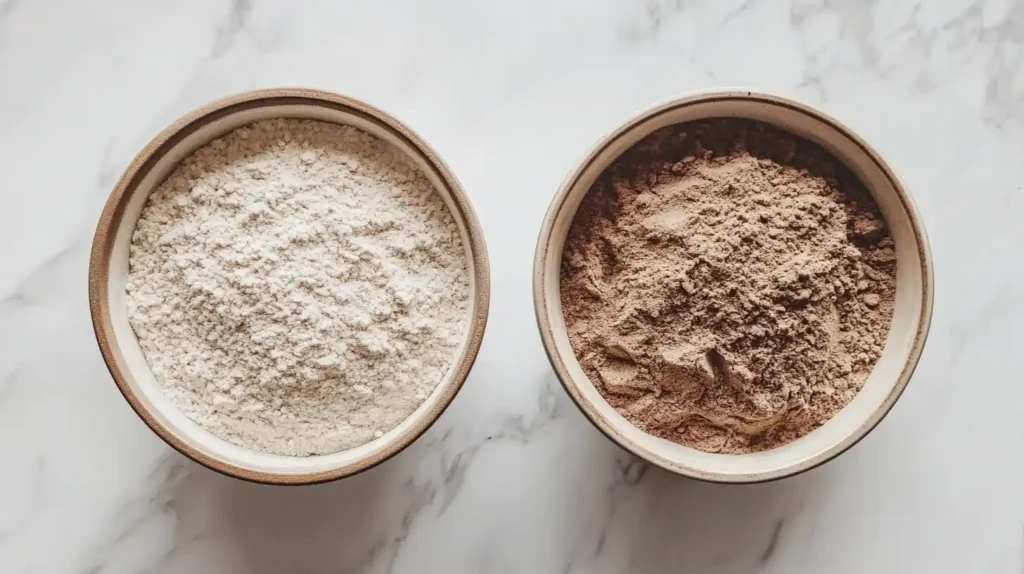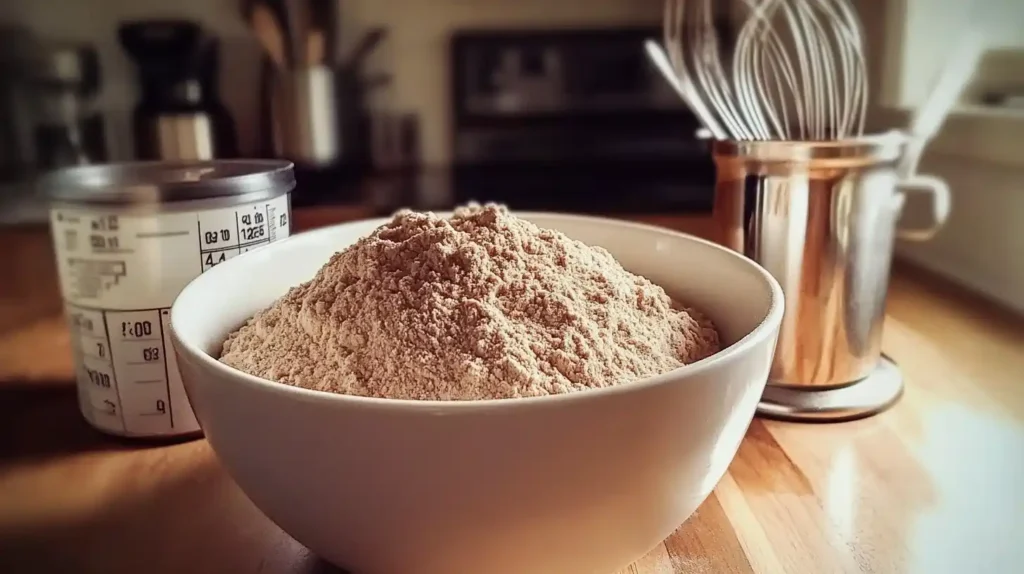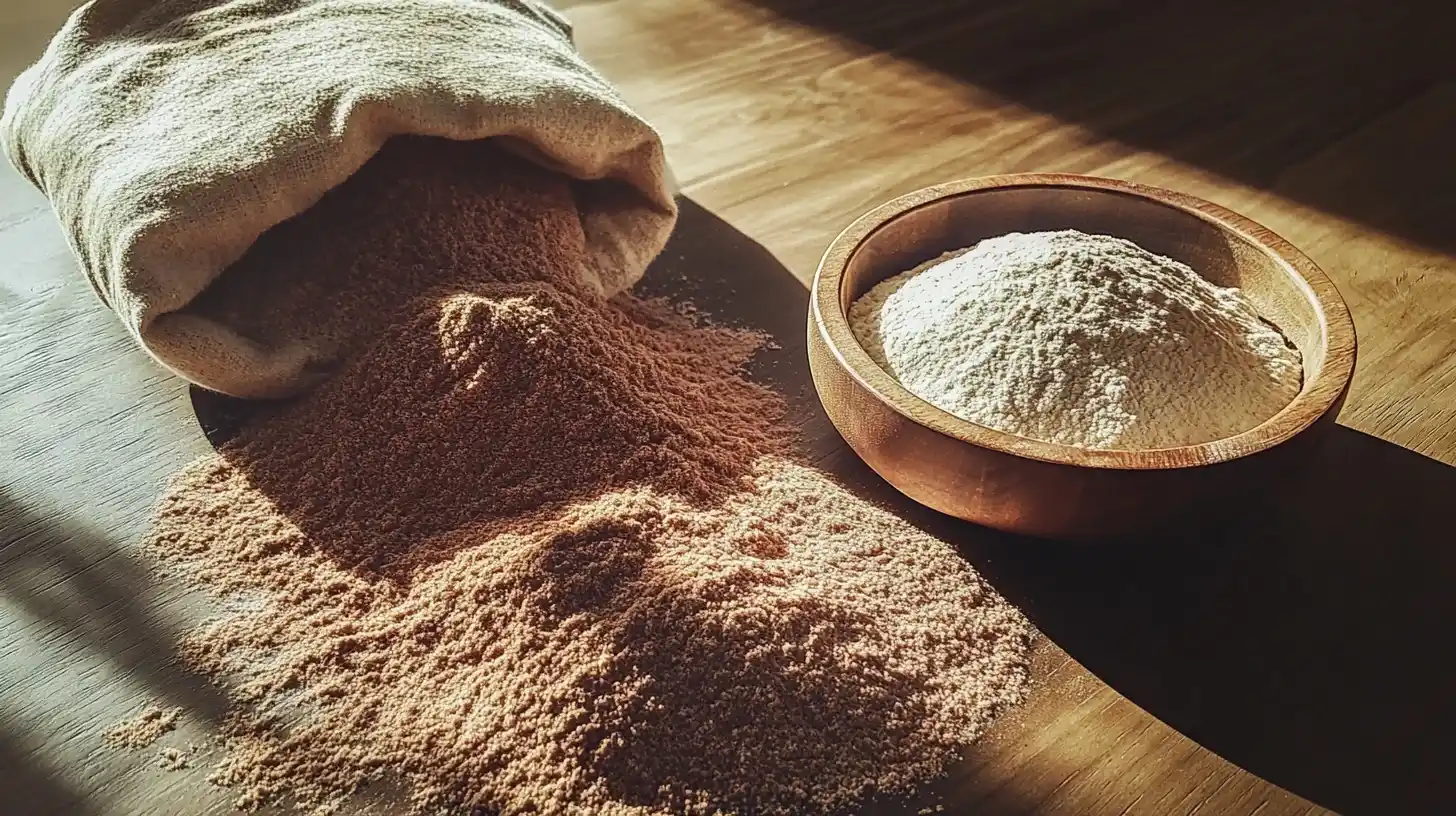Many people wonder: Can you replace regular flour with buckwheat flour in baking and cooking? Whether you’re looking for a gluten-free flour alternative or want to try a more nutritious option, buckwheat flour is a great choice. However, before making the switch, it’s important to understand how buckwheat flour compares to regular flour in terms of texture, taste, binding ability, and nutritional value.
If you are thinking about whether you can replace regular flour with buckwheat flour, you need to consider its lack of gluten, high fiber content, and unique taste. While it works well in some recipes, it may not be a perfect substitute for all baking needs. Let’s explore the key differences and the best ways to use buckwheat flour effectively.
Table of contents
- What is Buckwheat Flour ?
- How is Buckwheat Flour Different from Regular Flour ?
- 1. Gluten Content: Elasticity vs. Gluten-Free Structure
- 2. Texture and Binding Ability
- 3. Liquid Absorption and Hydration Needs
- 4. Flavor Profile: Mild vs. Distinctive
- 5. Nutritional Differences: A More Nutrient-Dense Option
- 6. Best Uses: Where Each Flour Performs Well
- 7. Baking Adjustments for Using Buckwheat Flour
- Can You Replace Regular Flour with Buckwheat Flour ?
- Best Recipes for Buckwheat Flour
- How to Adjust Recipes When Using Buckwheat Flour
- Health Benefits of Using Buckwheat Flour Over Regular Flour
- 1. Naturally Gluten-Free for Improved Digestive Health
- 2. Rich in Fiber for Better Digestion and Gut Health
- 3. Helps Manage Blood Sugar Levels
- 4. Supports Heart Health and Reduces Cholesterol
- 5. High in Protein for Muscle and Bone Health
- 6. Contains Antioxidants for Anti-Inflammatory Benefits
- 7. Supports Weight Management and Keeps You Fuller Longer
- Common Mistakes When Using Buckwheat Flour
- FAQs: People Also Ask About Replacing Regular Flour with Buckwheat Flour
- Final Thoughts

What is Buckwheat Flour?
Before understanding whether you can replace regular flour with buckwheat flour, it’s essential to know what buckwheat flour is.
Unlike regular flour, which is derived from wheat, buckwheat flour comes from ground buckwheat seeds, making it a naturally gluten-free alternative. It is commonly used in gluten-free baking and offers numerous health benefits, such as higher fiber, antioxidants, and essential nutrients.
Key Nutritional Benefits of Buckwheat Flour
- 100% Gluten-Free – Safe for people with celiac disease and gluten intolerance.
- High in Fiber – Supports digestion and helps maintain blood sugar levels.
- Rich in Antioxidants – Contains rutin, which benefits heart health.
- Plant-Based Protein – Ideal for vegans and vegetarians.
Nutritional Benefits of Buckwheat Flour
- High in fiber, which supports digestion
- Packed with antioxidants and magnesium
- Contains plant-based protein, making it a good choice for vegans
- Naturally gluten-free, ideal for people with celiac disease
For a deeper look at buckwheat flour’s health benefits, check out this complete guide to buckwheat flour.
How is Buckwheat Flour Different from Regular Flour?
Switching from regular flour to buckwheat flour requires understanding their differences. While both are commonly used in baking and cooking, many people wonder, can you replace regular flour with buckwheat flour in all recipes? Their unique characteristics affect texture, moisture absorption, and overall performance in baked goods. These differences influence the structure of recipes and determine how each flour should be used. Below is a detailed comparison of their key features.
1. Gluten Content: Elasticity vs. Gluten-Free Structure
One of the biggest differences between buckwheat flour and regular flour is the presence of gluten.
Regular Flour (All-Purpose, Bread Flour, Whole Wheat Flour)
- Contains gluten, which provides dough with elasticity and strength.
- Essential for recipes that require structure, such as bread and pizza dough.
- Traps air, creating a light and fluffy texture in cakes and pastries.
Buckwheat Flour
- Naturally gluten-free, making it ideal for people with gluten intolerance.
- Lacks elasticity, which leads to a denser and more delicate texture.
- Requires binders like eggs, flaxseed, psyllium husk, or xanthan gum to hold baked goods together.
Why This Matters
If a recipe relies on gluten for texture, substituting regular flour with buckwheat flour may require adjustments to achieve the desired consistency.
2. Texture and Binding Ability
The structural properties of these flours impact the final texture of baked goods.
Regular Flour
- Produces a smooth, elastic dough that holds its shape well.
- Forms a consistent, stretchy texture, which is ideal for chewy bread and soft cakes.
- Allows cakes and pastries to rise evenly by providing aeration.
Buckwheat Flour
- Has a crumbly and dense texture due to its lack of gluten.
- Absorbs more moisture, which can make baked goods dry if adjustments are not made.
- Works well in pancakes, crepes, muffins, and flatbreads, where a slightly dense texture is acceptable.
How to Improve Texture
To create a better structure, combine buckwheat flour with gluten-free flours such as almond, rice, oat, or tapioca flour. Adding binding agents also improves consistency.
3. Liquid Absorption and Hydration Needs
The way these flours interact with liquids affects the texture of baked goods.
Regular Flour
- Absorbs liquid evenly and gradually, making it easier to control dough consistency.
- Helps retain moisture, preventing dryness in baked goods.
Buckwheat Flour
- Absorbs liquid quickly, which can result in thick batters and dry dough.
- Requires extra moisture to prevent a dense and crumbly texture.
Adjustment Tip
When using buckwheat flour instead of regular flour, increasing the liquid content by adding more milk, water, or oil helps maintain the right consistency.
4. Flavor Profile: Mild vs. Distinctive
Taste can influence whether a flour works well in a particular recipe.
Regular Flour
- Has a mild, neutral flavor, allowing it to blend well with different ingredients.
- Works equally well in sweet and savory recipes without altering the taste.
Buckwheat Flour
- Offers a rich, nutty, and earthy taste, which may not be suitable for all recipes.
- Can have a slight bitterness, especially when used in large amounts.
Best Flavor Pairings
To balance its strong flavor, pair buckwheat flour with ingredients such as honey, vanilla, cinnamon, cocoa powder, or maple syrup in baking.
5. Nutritional Differences: A More Nutrient-Dense Option
Beyond structural differences, buckwheat flour provides several nutritional benefits.
| Nutrient | Buckwheat Flour | Regular Flour (All-Purpose) |
|---|---|---|
| Protein | High (rich in plant-based protein) | Moderate |
| Fiber | High (supports digestion) | Lower |
| Carbohydrates | Moderate | High |
| Gluten | None (100% gluten-free) | High |
| Vitamins & Minerals | High in magnesium, iron, and B vitamins | Lower |
| Antioxidants | Rich in rutin (anti-inflammatory properties) | Minimal |

Why It’s Beneficial
Since buckwheat flour has a lower glycemic index and a higher fiber content, it helps support better digestion and blood sugar control, making it a popular choice for health-conscious baking.
6. Best Uses: Where Each Flour Performs Well
Each type of flour works best in different recipes due to its unique properties.
Regular Flour is Best for:
- Yeast-based bread, where gluten is needed for elasticity.
- Cakes and cookies, which require a light and fluffy texture.
- Pasta and pizza dough, where a firm, chewy consistency is ideal.
Buckwheat Flour Excels in:
- Pancakes and crepes, where its slightly dense texture is desirable.
- Muffins and quick breads, especially when blended with other flours.
- Flatbreads and wraps, as it holds shape well despite being gluten-free.
- Gluten-free noodles, such as Japanese soba noodles.
Blending Flours for Better Results
Many bakers prefer mixing buckwheat flour with regular flour or other gluten-free options to achieve the right balance of texture and structure.
7. Baking Adjustments for Using Buckwheat Flour
Replacing regular flour with buckwheat flour requires some modifications:
- Increase Liquid Content – Add 10–15% more liquid to prevent dryness.
- Use Binders – Include eggs, flaxseeds, or xanthan gum to improve structure.
- Lower Baking Temperature – Buckwheat flour browns faster, so reduce the heat by 5–10°C (10–20°F).
- Blend with Other Flours – Combining buckwheat flour with almond, rice, or tapioca flour enhances texture.
- Enhance Flavor – Use vanilla, cinnamon, or cocoa powder to balance its strong taste.
Can You Replace Regular Flour with Buckwheat Flour?
The short answer is: Yes, but adjustments are necessary. While buckwheat flour can be used in place of regular flour, it does not behave the same way because it lacks gluten
1:1 Substitution – Does It Work?
A direct replacement does not always produce the best results. Since buckwheat flour lacks gluten, a full substitution can make baked goods dense or crumbly.
Best Approach: Blend with Other Flours
For better texture, mix buckwheat flour with:
- Almond flour – adds moisture and softness
- Rice flour – improves crispness
- Tapioca starch – enhances elasticity
How Much Buckwheat Flour to Use?
- 25% replacement – Works well in bread and cakes
- 50% replacement – Suitable for cookies and muffins
- 100% replacement – Best for pancakes and crepes
Best Recipes for Buckwheat Flour
Some recipes work well with buckwheat flour, while others need modifications.
Great Uses for Buckwheat Flour
- Pancakes – Soft and fluffy with a rich flavor
- Muffins & Quick Breads – Blending with other flours helps retain moisture
- Crepes – Traditionally made with 100% buckwheat flour
- Noodles & Flatbreads – Used in dishes like Japanese soba noodles
Recipes That Require Adjustments
- Cakes & Cookies – Blending with regular flour creates a balanced texture
- Yeast Bread – Needs extra binders to hold its shape
How to Adjust Recipes When Using Buckwheat Flour
To achieve the best results, slight modifications to baking methods are necessary.
Increase Liquid Content
Since buckwheat flour absorbs more moisture, adding a little extra milk, water, or oil prevents dryness.
Use Binders for Better Texture
Incorporating eggs, flaxseeds, or xanthan gum improves the structure of baked goods.
Lower Baking Temperature
Because buckwheat flour browns more quickly than regular flour, reducing the oven temperature by 5–10°C (10–20°F) prevents over-browning.
Balance the Flavor
Since buckwheat flour has a distinct taste, pairing it with these ingredients enhances the overall flavor:
- Vanilla & Cinnamon – Adds warmth and sweetness
- Cocoa Powder – Reduces bitterness
- Honey or Maple Syrup – Creates a well-rounded flavor profile

Health Benefits of Using Buckwheat Flour Over Regular Flour
Not only can you replace regular flour with buckwheat flour, but doing so provides several health benefits, making it a better choice for many people.
1. Naturally Gluten-Free
Because buckwheat flour is gluten-free, it is ideal for individuals with celiac disease or gluten intolerance.
2. High in Fiber for Digestive Health
Unlike regular flour, which has a high glycemic index, buckwheat flour regulates blood sugar levels and helps improve digestion.
3. Supports Heart Health
Since buckwheat flour is rich in rutin, it helps lower cholesterol, reduce inflammation, and improve circulation.
4. High in Protein for Muscle and Bone Strength
Unlike regular flour, buckwheat flour contains complete plant-based protein, which helps maintain muscle mass and bone health.
1. Naturally Gluten-Free for Improved Digestive Health
One of the primary reasons people choose buckwheat flour over regular flour is its gluten-free nature.
Why This Matters
- Regular flour, especially all-purpose and bread flour, contains gluten, a protein that can cause digestive issues in some individuals.
- Buckwheat flour, on the other hand, is completely gluten-free, making it ideal for people with celiac disease, gluten sensitivity, or wheat allergies.
- By avoiding gluten, individuals can reduce inflammation in the gut and prevent symptoms like bloating, cramps, and fatigue.
Best for:
- People with celiac disease
- Those with irritable bowel syndrome (IBS)
- Individuals looking to follow a gluten-free diet
2. Rich in Fiber for Better Digestion and Gut Health
Buckwheat flour is significantly higher in fiber than regular flour, which plays a key role in supporting digestion and preventing constipation.
How Fiber Benefits the Body
- Promotes Healthy Digestion – Fiber adds bulk to stool, making it easier to pass.
- Feeds Good Gut Bacteria – Supports a healthy microbiome, improving overall gut function.
- Reduces Bloating and Constipation – Helps keep bowel movements regular.
In contrast, regular flour—especially refined white flour—contains very little fiber because the bran and germ are removed during processing. This can lead to slower digestion, increased hunger, and poor gut health.
Best for:
- Individuals looking to improve digestion
- Those aiming to increase fiber intake
- People managing constipation or bloating
3. Helps Manage Blood Sugar Levels
One of the biggest health benefits of buckwheat flour over regular flour is its lower glycemic index (GI).
Why Glycemic Index Matters
- The glycemic index (GI) measures how quickly a food raises blood sugar.
- Regular flour, especially white flour, has a high GI, causing rapid spikes and crashes in blood sugar levels.
- Buckwheat flour has a low GI, which helps keep blood sugar levels stable.
Health Benefits of Lower Blood Sugar Spikes
- Prevents Insulin Resistance – Reduces the risk of type 2 diabetes.
- Sustains Energy Levels – Avoids sudden crashes after meals.
- Controls Hunger – Prevents cravings by keeping blood sugar steady.
Studies show that swapping regular flour for buckwheat flour can be beneficial for individuals with prediabetes, diabetes, or metabolic syndrome.
Best for:
- People with diabetes or prediabetes
- Those looking for better energy balance
- Individuals wanting to avoid sugar cravings
4. Supports Heart Health and Reduces Cholesterol
Eating buckwheat flour instead of regular flour may help lower cholesterol and improve heart health.
How Buckwheat Flour Benefits the Heart
- Rich in Rutin – This powerful antioxidant reduces inflammation, strengthens blood vessels, and improves circulation.
- Helps Lower Bad Cholesterol (LDL) – Studies show buckwheat flour helps reduce LDL cholesterol, which contributes to heart disease.
- Increases Good Cholesterol (HDL) – Supports better cardiovascular health.
- Contains Magnesium – Helps relax blood vessels, improving blood flow and reducing high blood pressure.
By contrast, regular flour—especially refined white flour—can contribute to high cholesterol, arterial plaque buildup, and increased risk of heart disease.
Best for:
- Individuals with high cholesterol
- Those with a family history of heart disease
- People aiming to improve cardiovascular health
5. High in Protein for Muscle and Bone Health
Unlike regular flour, which has low to moderate protein content, buckwheat flour is a complete protein source, meaning it contains all nine essential amino acids.
Why Protein Matters
- Supports Muscle Growth and Repair – Essential for athletes, bodybuilders, and active individuals.
- Strengthens Bones – Helps maintain bone density, reducing the risk of osteoporosis.
- Improves Satiety – Keeps you fuller for longer, aiding in weight management.
Because buckwheat flour is plant-based, it is a great choice for vegans and vegetarians looking to increase protein intake without relying on animal products.
Best for:
- Athletes and active individuals
- Vegans and vegetarians
- People at risk for osteoporosis
6. Contains Antioxidants for Anti-Inflammatory Benefits
Another major advantage of buckwheat flour over regular flour is its high antioxidant content.
Key Antioxidants in Buckwheat Flour
- Rutin – Helps reduce inflammation and protects against cell damage.
- Quercetin – Known for its immune-boosting and anti-inflammatory properties.
- Magnesium & Zinc – Support immune function, reduce stress, and improve overall wellness.
In contrast, regular flour, especially refined white flour, is stripped of most nutrients and lacks significant antioxidant properties. This makes it less beneficial for fighting inflammation and protecting cells from damage.
Best for:
- People with chronic inflammation
- Those looking to boost immune health
- Individuals seeking anti-aging benefits
7. Supports Weight Management and Keeps You Fuller Longer
Replacing regular flour with buckwheat flour may also aid in weight management due to its high fiber and protein content.
How Buckwheat Flour Helps with Weight Control
- Increases Fullness – Fiber slows digestion, keeping you fuller for longer.
- Prevents Overeating – Reduces hunger cravings and snacking between meals.
- Boosts Metabolism – High protein content helps the body burn more calories efficiently.
On the other hand, regular flour, especially white flour, lacks fiber and protein, which can lead to faster digestion, increased hunger, and overeating.
Best for:
- Individuals trying to lose or maintain weight
- People looking for more filling, satisfying meals
- Those following a balanced, high-fiber diet
Common Mistakes When Using Buckwheat Flour
When replacing regular flour with buckwheat flour, avoid these common mistakes:
Using 100% Buckwheat Flour in Every Recipe
A full replacement often results in dry, crumbly textures.
Ignoring the Need for Binders
Adding eggs, xanthan gum, or a suitable alternative prevents baked goods from falling apart.
Not Adjusting Liquid Content
Since buckwheat flour absorbs more moisture, extra liquid helps maintain the right consistency.
Overlooking Flavor Balance
The nutty taste of buckwheat flour can overpower some dishes, so adding mild sweeteners or spices enhances the final product.
FAQs: People Also Ask About Replacing Regular Flour with Buckwheat Flour
Many people considering buckwheat flour as a substitute for regular flour have common questions about its properties, usage, and effects on baking. Below are some frequently asked questions to help clarify when and how to use buckwheat flour effectively.
1. Can I Replace Regular Flour with Buckwheat Flour in Any Recipe?
Not in all recipes. Because buckwheat flour does not contain gluten, it behaves differently in baking. It works well in pancakes, crepes, muffins, and cookies but may not be a perfect substitute for bread or other yeast-based recipes that rely on gluten for structure.
Best Practice:
- For bread and cakes, mix buckwheat flour with another flour for better texture.
- In flatbreads, pancakes, and cookies, a 1:1 substitution often works without major issues.
2. Does Buckwheat Flour Make Baked Goods Denser?
Yes, buckwheat flour tends to create denser and more crumbly baked goods because it lacks gluten, which provides elasticity and structure.
How to Fix It:
- Use binders like eggs, flaxseeds, or xanthan gum.
- Blend with other gluten-free flours like almond or rice flour for a lighter texture.
3. How Does Buckwheat Flour Affect the Taste of Baked Goods?
Buckwheat flour has a strong, nutty, and earthy flavor, which is quite different from the neutral taste of regular flour. Some people enjoy its depth, while others find it slightly bitter in large amounts.
How to Balance the Flavor:
- Use sweeteners like honey, maple syrup, or vanilla extract.
- Combine with spices such as cinnamon or nutmeg for a milder taste.
- Mix with neutral-tasting flours to reduce intensity.
4. Can You Use Buckwheat Flour for Bread-Making?
Yes, but with adjustments. Since buckwheat flour lacks gluten, yeast-based breads made solely with buckwheat flour may not rise as well as those made with regular flour.
Best Approach:
- Blend buckwheat flour with other flours like whole wheat, oat, or sorghum.
- Add binders such as eggs or psyllium husk to improve elasticity.
- Use baking powder or baking soda instead of yeast for quick breads.
5. Is Buckwheat Flour Good for Weight Loss?
Yes, buckwheat flour can help with weight management because it is high in fiber and protein, which promote satiety and reduce overeating.
Benefits for Weight Control:
- Keeps you fuller for longer, reducing hunger.
- Stabilizes blood sugar levels, preventing cravings.
- Has fewer calories than some refined flours.
6. What Is the Best Ratio of Buckwheat Flour to Regular Flour?
The best ratio depends on the recipe and desired texture.
Recommended Ratios:
- 25-50% buckwheat flour – Best for cakes, muffins, and cookies.
- 50-75% buckwheat flour – Suitable for pancakes and crepes.
- 100% buckwheat flour – Works well for flatbreads and soba noodles.
Mixing buckwheat flour with another flour often improves texture and structure, especially in baked goods that need some elasticity.
7. How Does Buckwheat Flour Compare Nutritionally to Regular Flour?
To determine whether you can replace regular flour with buckwheat flour, it’s important to compare their texture, absorption rate, and overall baking behavior.
| Nutrient | Buckwheat Flour | Regular Flour (All-Purpose) |
|---|---|---|
| Protein | Higher | Moderate |
| Fiber | High | Low |
| Gluten | None | High |
| Glycemic Index | Low (better for blood sugar) | High |
| Magnesium & Iron | Rich | Minimal |
Because of these nutritional advantages, buckwheat flour is a healthier alternative to regular flour, particularly for people looking to improve digestion, heart health, and energy levels.
8. What Is the Best Way to Store Buckwheat Flour?
Since buckwheat flour contains natural oils, it can spoil faster than regular flour if not stored properly.
Storage Tips:
- Keep it in an airtight container to prevent moisture absorption.
- Store in a cool, dark place like a pantry for up to 3 months.
- Refrigerate or freeze for longer shelf life (up to 6-12 months).
Proper storage helps maintain freshness and prevents rancidity.
9. Are There Any Side Effects of Consuming Too Much Buckwheat Flour?
Although buckwheat flour is generally safe, excessive consumption may cause:
- Digestive discomfort due to its high fiber content.
- Allergic reactions in rare cases (buckwheat allergies are uncommon but possible).
- Blood sugar drops in individuals sensitive to low-glycemic foods.
To avoid potential issues, introduce buckwheat flour gradually into your diet.
10. Can Buckwheat Flour Be Used in Savory Dishes?
Yes, buckwheat flour works well in both sweet and savory recipes. While it is commonly used in pancakes, waffles, and muffins, it is also excellent for:
- Soba noodles (a Japanese classic made from buckwheat).
- Flatbreads and wraps (ideal for gluten-free diets).
- Coating for fried foods (adds a crispy texture).
Its earthy flavor pairs well with herbs, spices, and roasted vegetables, making it a versatile ingredient for savory cooking.
Final Thoughts
So, can you replace regular flour with buckwheat flour? Yes, but it depends on the recipe. While buckwheat flour works well in pancakes, crepes, and muffins, it requires adjustments in bread and cake recipes to achieve the best texture.
Not only is buckwheat flour a nutritious alternative, but it also provides gluten-free, high-fiber, and protein-rich benefits that support overall health. By making small adjustments, you can enjoy the unique taste and advantages of buckwheat flour in your favorite recipes.
By following these tips, you can create delicious, well-textured baked goods while benefiting from the health advantages of buckwheat flour. Now, it’s time to experiment with new recipes and enjoy the results.

